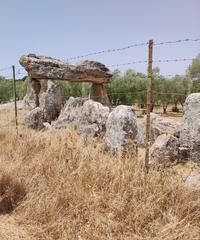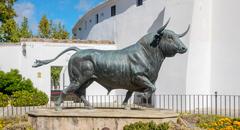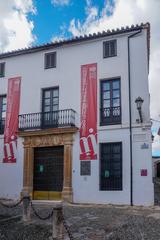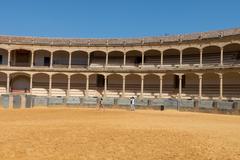Torre de Lifa, Ronda, Spain: Visiting Hours, Tickets, and Travel Guide
Date: 03/07/2025
Introduction
Nestled in the pristine Valle de Lifa within the Sierra de las Nieves Natural Park, Torre de Lifa is a medieval watchtower that offers a unique blend of Andalusia’s historical depth and breathtaking landscapes. Believed to have originated during the 13th or 14th century—possibly with earlier Moorish roots—the tower guarded strategic routes between El Burgo and Ronda during the Islamic Nasrid dynasty and later Christian Reconquista. Today, Torre de Lifa remains a poignant ruin, providing panoramic views of the Turón River canyon and a window into the region’s rich ecological and cultural legacy (malaga.es, adventurebackpack.com, i-sierradelasnieves.com).
Table of Contents
- Introduction
- Historical Background and Significance
- Architectural Features
- Visiting Torre de Lifa
- Nearby Attractions and Outdoor Activities
- Culture, Nature, and Conservation
- Frequently Asked Questions (FAQ)
- Visuals and Media Suggestions
- Summary and Visitor Tips
- References
Historical Background and Significance
Torre de Lifa is emblematic of Ronda’s historical crossroads, serving as a sentinel throughout centuries of conflict and change. Its strategic location atop a rocky escarpment allowed it to oversee important trade and military routes, especially during the turbulent periods of the Nasrid kingdom and the Reconquista (malaga.es).
Moorish and Medieval Heritage
Archaeological remains suggest occupation dating back to Roman times, but the most significant period was during the Islamic era, particularly under the Nasrid dynasty in the 14th century. The tower formed part of a network of watchtowers (atalayas) that communicated via signals—critical in defending the last Muslim frontier in the Iberian Peninsula (adventurebackpack.com).
The Bobastro Rebellion
Torre de Lifa is also linked to the 9th-century Bobastro rebellion led by Umar ibn Hafsún, a pivotal episode that saw local fortifications like Lifa targeted by the Umayyad Emirate in their efforts to suppress dissent (diarioronda.es).
Architectural Features
- Design: The tower, now mostly in ruins, was constructed from local limestone using the mampuesto technique (roughly hewn stones packed with rubble). It features thick walls, an elevated entrance, and a simple cylindrical chamber—typical of Moorish military architecture (malaga.es).
- Defensive Function: Narrow slits in the walls allowed for surveillance and signaling. The tower’s location provided a commanding view of the Lifa valley and the approaches to Ronda.
- Surroundings: Remnants of Roman occupation and later medieval settlements are found nearby, emphasizing the valley’s long-standing strategic importance (i-sierradelasnieves.com).
Visiting Torre de Lifa
Visiting Hours and Tickets
- Hours: Torre de Lifa is an open-access, outdoor site with no fixed opening or closing hours. Daylight visits are recommended for safety.
- Tickets: Admission is free. There are no facilities or ticket offices. Donations for preservation are appreciated if available (yourcostadelsolguide.com).
How to Get There
- From Ronda: Torre de Lifa is about 15–20 km northeast of Ronda. The most common approach is from El Burgo, following the GR-243 (Ronda–Lifa) or GR-249 (Gran Senda de Málaga) trailheads.
- Trail Distance: Round-trip hikes range from 12 km (from Puerto de los Quejigales) to 18 km (from El Burgo), with 400–600 meters elevation gain. Allow 4–7 hours, depending on route and fitness (wikiloc.com).
- Parking: Limited parking is available in El Burgo; the trailhead is well-marked.
Accessibility and Visitor Tips
- Terrain: The hike involves uneven, rocky paths and some steep climbs. Not wheelchair accessible.
- Preparation: Wear sturdy boots, bring water (2+ liters/person), snacks, sun protection, and a map or GPS device.
- Safety: Mobile coverage is limited. Inform someone of your plans before heading out.
- Weather: Spring and autumn are ideal for visiting. Summers can be hot, with fire-risk restrictions; winters may bring mud or occasional snow (i-sierradelasnieves.com).
Seasonal and Environmental Considerations
- Summer Restrictions: Vehicle access to forest tracks may be limited (July–August) due to fire danger. Plan for longer hikes if parking farther away.
- River Crossings: After heavy rain, river crossings can be challenging; check local trail conditions before departing.
Guided Tours and Organized Excursions
- Guided Hikes: Local hiking clubs and tour operators in Ronda and El Burgo offer guided excursions, often combining natural and historical interpretation (yourcostadelsolguide.com).
- Languages: Tours are typically in Spanish, with some available in English and French. Booking ahead is advised during peak seasons.
Regulations and Restrictions
- Protected Area: Torre de Lifa sits within a UNESCO Biosphere Reserve. Stay on marked trails, avoid lighting fires, and respect wildlife.
- Hunting Season: Some trails may be closed during hunting periods (mostly autumn and winter weekends). Check with local authorities or the El Burgo Town Hall for up-to-date information (wikiloc.com).
Nearby Attractions and Outdoor Activities
- Other Historical Sites: Visit castles at El Burgo, Las Cuevas, Ardales, and Cañete to explore the wider medieval defensive network.
- Nature Trails: The Sierra de las Nieves offers hiking, mountain biking, and birdwatching. Trails range from moderate walks to challenging ascents like Torrecilla (1,919 m).
- Outdoor Adventures: Try canyoning, via ferrata, horseback riding, or paragliding in the region (Hike+Bike Holidays).
- Ronda Highlights: Pair your hike with visits to Ronda’s old town, the Puente Nuevo bridge, or the ancient bullring (thevivalavita.com).
Culture, Nature, and Conservation
Cultural Integration
Torre de Lifa forms part of Ronda’s rich cultural landscape, reflecting the interplay of Moorish and Christian influences. Folklore, local legends, and educational trails celebrate its role in Andalusian history (adventurebackpack.com).
Natural Heritage
The tower’s setting within the Sierra de las Nieves Natural Park means visitors experience rare species like the Spanish fir (Abies pinsapo), Mediterranean pine, holm oak, and cornicabra trees. The area also boasts diverse wildlife, including ibex, eagles, and vultures (i-sierradelasnieves.com).
Conservation Status
Despite its significance, Torre de Lifa is in advanced decay, with limited conservation efforts. Visitors are encouraged to respect the site and support local initiatives for heritage preservation (diarioronda.es).
Frequently Asked Questions (FAQ)
Q: What are the visiting hours for Torre de Lifa?
A: The site is open year-round, but daylight visits are strongly recommended.
Q: Is there an entrance fee?
A: No, access is free.
Q: How do I get there?
A: Via hiking trails from El Burgo (main access point) or the Puerto de los Quejigales trailhead, both northeast of Ronda.
Q: Is the hike suitable for beginners or children?
A: The route is moderately strenuous and better suited for experienced hikers and older children.
Q: Are guided tours available?
A: Yes, local tour operators and hiking clubs offer guided excursions.
Q: Are there facilities on site?
A: No, there are no toilets, water fountains, or shops on the trail or at the tower.
Q: Is the tower accessible for people with limited mobility?
A: No, the rugged terrain and uneven paths make it inaccessible for wheelchairs.
Q: Can I combine this visit with other attractions?
A: Absolutely. Many visitors explore Ronda’s historic sites or other natural park trails on the same trip.
Visuals and Media Suggestions
- Images: Share photographs of Torre de Lifa’s ruins, panoramic views of the valley, and local flora and fauna.
Alt tags: “Torre de Lifa ruins in Ronda,” “Panoramic view from Torre de Lifa,” “Map of hiking trail to Torre de Lifa.” - Maps: Include interactive or downloadable trail maps from El Burgo and Puerto de los Quejigales.
- Virtual Tours: Feature links to 360° virtual walks or video guides if available from local tourism offices.
Summary and Visitor Tips
Torre de Lifa is a must-see for those seeking a blend of history, scenic hiking, and natural beauty near Ronda. With open access year-round and no entrance fees, it invites exploration by well-prepared hikers who respect the natural and cultural environment. The tower’s story—spanning Moorish, Christian, and even Roman chapters—comes alive through its dramatic setting and the legends that surround it (malaga.es, adventurebackpack.com, i-sierradelasnieves.com, wikiloc.com).
Visitor Tips:
- Start early to avoid heat and crowds.
- Wear sturdy shoes and bring plenty of water.
- Respect wildlife and Leave No Trace.
- Consider a guided tour for deeper insights.
- Combine your hike with other Ronda attractions for a full day of discovery.
For the latest updates, maps, and guided audio tours, download the Audiala app and follow us on social media.
References
- Torre de Lifa Visiting Hours, Tickets & History | Explore Ronda’s Historic Watchtower, 2024, Malaga.es (malaga.es)
- Torre De Lifa: Visiting Hours, Tickets, and Exploring Ronda’s Historic Watchtower, 2024, Adventure Backpack (adventurebackpack.com)
- Visiting Torre de Lifa: Hours, Tickets, Access, and Guided Tours for Exploring Ronda’s Historical Site, 2024, i-Sierra de las Nieves (i-sierradelasnieves.com)
- Torre De Lifa Hiking Guide: Visiting Hours, Trails, and Outdoor Activities near Málaga, 2024, Wikiloc & Hike+Bike Holidays (wikiloc.com)
- La Torre de Lifa, 2018, Diario Ronda (diarioronda.es)
- Ronda Spain Travel Guide, 2024, Turispanish (turispanish.com)
- Ronda Tours and Visitor Information, 2024, Your Costa del Sol Guide (yourcostadelsolguide.com)



